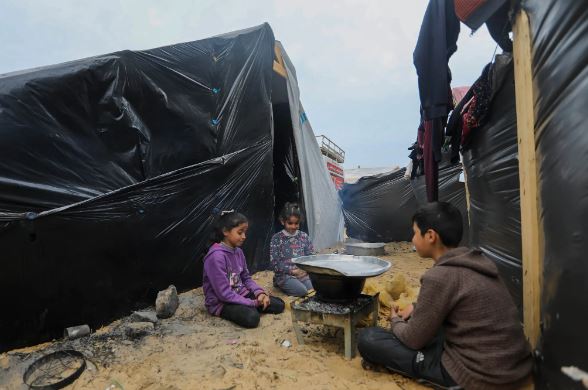In the midst of chilly nights, amidst relentless rains and plummeting temperatures, Heba and Ehab Ahmad found solace in holding their two youngest children close. Clinging to each other, the family sought warmth under a thin blanket in their makeshift tent, vulnerable to the elements that penetrated through the gaps in their temporary shelter.
The Ahmads, numbering among the 1.9 million displaced Gazans, endured the aftermath of Israel’s intense bombing campaign and the subsequent ground operations, retaliation for the Hamas-led attacks on Israel starting on October 7.
Three weeks ago, the Ahmad family sought refuge in Gaza’s southern Al-Mawasi neighborhood, just as winter set in. A family of seven, they huddled in a small, flimsy tent constructed from overpriced nylon sheets and a few wooden planks. This makeshift abode is shared with 16 other relatives, highlighting the dire living conditions imposed by the conflict.
By day, Ehab and his eldest sons scavenge for firewood and cardboard, struggling to maintain a small fire for cooking and warmth. “I’m speaking to you while the smoke from the fire is blinding me,” Ehab mentioned during a phone interview.
Concerns about the spread of waterborne diseases, including cholera and chronic diarrhea, have escalated in Gaza due to the lack of clean water and unsanitary conditions. Children, in particular, bear the brunt of rising infectious diseases, as stated by UNICEF.
Jana, the Ahmad’s only daughter and youngest child at 9, has endured severe abdominal pain for nearly two weeks, likely from extreme dehydration. However, the overwhelmed and inaccessible medical centers have made it impossible for the family to seek professional help.
“She’s been screaming in pain, and all we can do is give her some of the rainwater to drink,” Ehab Ahmad said.
When the Ahmads fled their home in Beit Hanoun during the early days of the war, the weather was still warm. Like many others, they didn’t anticipate the prolonged displacement, leaving with only essential documents and the summer clothes on their backs.
The Integrated Food Security Phase Classification, a collaboration of international aid organizations, recently classified Gaza’s entire population as experiencing a food crisis.
The Ahmads, having moved four times since the war began, have faced immense challenges in accessing food and water. Foraging for wild leafy greens has become their primary means of sustenance, as aid struggles to reach them due to fuel shortages, ongoing airstrikes, and logistical hurdles.
Amidst the hardships, a silver lining emerges with the rainy weather—a brief respite from the daily struggle to find water. Placing a bucket outside their tent, the family collects rainwater for cooking, washing, and cleaning.
“It is still contaminated water,” Ehab Ahmad acknowledged, “but we have no other alternative. We need to adapt.”
In the midst of this humanitarian crisis, the Ahmad family symbolizes the countless lives grappling with the harsh realities of displacement, underscoring the urgent need for international aid and sustainable solutions to alleviate the suffering in the Gaza Strip.

